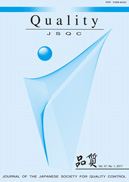Volume 44, Issue 1
Displaying 1-14 of 14 articles from this issue
- |<
- <
- 1
- >
- >|
Features
-
Article type: Features 〔The Beginning of Quality Control ~Searching for the Roots of Quality Control~Part3〕
2014Volume 44Issue 1 Pages 5-11
Published: January 15, 2014
Released on J-STAGE: June 05, 2017
Download PDF (957K) -
Article type: Features 〔The Beginning of Quality Control ~Searching for the Roots of Quality Control~Part3〕
2014Volume 44Issue 1 Pages 12-18
Published: January 15, 2014
Released on J-STAGE: June 05, 2017
Download PDF (848K) -
Article type: Features 〔The Beginning of Quality Control ~Searching for the Roots of Quality Control~Part3〕
2014Volume 44Issue 1 Pages 19-24
Published: January 15, 2014
Released on J-STAGE: June 05, 2017
Download PDF (832K) -
Article type: Features 〔The Beginning of Quality Control ~Searching for the Roots of Quality Control~Part3〕
2014Volume 44Issue 1 Pages 25-29
Published: January 15, 2014
Released on J-STAGE: June 05, 2017
Download PDF (686K) -
Article type: Features 〔The Beginning of Quality Control ~Searching for the Roots of Quality Control~Part3〕
2014Volume 44Issue 1 Pages 30-33
Published: January 15, 2014
Released on J-STAGE: June 05, 2017
Download PDF (486K) -
Article type: Features 〔The Beginning of Quality Control ~Searching for the Roots of Quality Control~Part3〕
2014Volume 44Issue 1 Pages 34-37
Published: January 15, 2014
Released on J-STAGE: June 05, 2017
Download PDF (530K) -
Article type: Features 〔The Beginning of Quality Control ~Searching for the Roots of Quality Control~Part3〕
2014Volume 44Issue 1 Pages 38-43
Published: January 15, 2014
Released on J-STAGE: June 05, 2017
Download PDF (935K) -
Article type: Features 〔The Beginning of Quality Control ~Searching for the Roots of Quality Control~Part3〕
2014Volume 44Issue 1 Pages 44-48
Published: January 15, 2014
Released on J-STAGE: June 05, 2017
Download PDF (629K) -
Article type: Features 〔The Beginning of Quality Control ~Searching for the Roots of Quality Control~Part3〕
2014Volume 44Issue 1 Pages 49-57
Published: January 15, 2014
Released on J-STAGE: June 05, 2017
Download PDF (1176K) -
Article type: Features 〔The Beginning of Quality Control ~Searching for the Roots of Quality Control~Part3〕
2014Volume 44Issue 1 Pages 58-64
Published: January 15, 2014
Released on J-STAGE: June 05, 2017
Download PDF (843K)
Serial
-
Article type: Serial [Understand the Specialty Skills for the Small and Medium-Sized Companies to Survive this Age of Change]
2014Volume 44Issue 1 Pages 65-69
Published: January 15, 2014
Released on J-STAGE: June 05, 2017
Download PDF (6374K) -
Article type: Serial [The New Thinking Method and Organization Management to Improve Values of Business〕
2014Volume 44Issue 1 Pages 71-76
Published: January 15, 2014
Released on J-STAGE: June 05, 2017
Download PDF (1449K)
Research Papers
Technical Note
-
Article type: Technical Note
2014Volume 44Issue 1 Pages 123-134
Published: January 15, 2014
Released on J-STAGE: June 05, 2017
Download PDF (1232K)
Quality Report
-
Article type: Quality Report
2014Volume 44Issue 1 Pages 135-145
Published: January 15, 2014
Released on J-STAGE: June 05, 2017
Download PDF (1655K)
- |<
- <
- 1
- >
- >|
